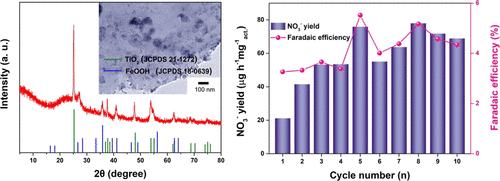2-甲基咪唑功能化聚吡咯/氧化石墨烯锚定feoh - tio2增强硝酸盐电合成稳定性
IF 8.2
2区 材料科学
Q1 MATERIALS SCIENCE, MULTIDISCIPLINARY
引用次数: 0
摘要
电催化氮氧化反应(NOR)技术为在温和条件下生产硝酸盐提供了一种环保、经济、可控的方法。NOR的进步很大程度上依赖于有效和负担得起的电催化剂的发现。这项研究揭示了一种新的方法,通过原位生长过程,包括2-MeIm基团和金属前体之间的离子交换和配位,将FeOOH-TiO2异质结构精心整合到2-甲基咪唑功能化聚吡咯/氧化石墨烯(2-MeIm/PPy/GO)的复杂底物上。所得FeOOH - TiO2@2-MeIm/PPy/GO在NOR过程中表现出明显的弹性,NO3 -产率达到83.24 μg h-1 mgact。-1,在1.94 V (vs可逆氢电极)时,法拉第效率(FE)峰值为5.47%。氮氧化主要发生在铁位点,TiO2中掺杂的Fe2+在此过程中全部逐渐转化为Fe3+;同时,FeOOH - TiO2@2-MeIm/PPy/GO中的钛位保持稳定的化学状态,确保有足够的电活性进行析氧反应(OER),以产生NOR中非电化学步骤所需的*O。铁和钛之间的这种协同作用对FeOOH - TiO2@2-MeIm/PPy/GO的稳定性和耐用性都有重要贡献,使其成为现实世界中NOR应用的有前途的候选者。这项工作为下一代可持续硝酸盐生产电催化剂的设计和制造提供了有价值的见解。本文章由计算机程序翻译,如有差异,请以英文原文为准。

Enhanced Stability for Nitrate Electrosynthesis by Heterogeneous FeOOH–TiO2 Anchored on 2-Methylimidazolium Functionalized Polypyrrole/Graphene Oxide
The electrocatalytic nitrogen oxidation reaction (NOR) technology offers an environmentally friendly, cost-efficient, and controllable method for nitrate production under mild conditions. Advances in NOR heavily rely on the discovery of effective and affordable electrocatalysts. This study unveils a novel approach by meticulously integrating FeOOH–TiO2 heterostructures onto a sophisticated substrate of 2-methylimidazolium functionalized polypyrrole/graphene oxide (2-MeIm/PPy/GO), through in situ growth processes involving ion-exchange and coordination between the 2-MeIm groups and metal precursors. The resulting FeOOH–TiO2@2-MeIm/PPy/GO exhibits remarkable resilience during the NOR process, which achieves a notable NO3– yield of 83.24 μg h–1 mgact.–1, accompanied by a peak Faradaic efficiency (FE) of 5.47% at 1.94 V (vs reversible hydrogen electrode). Nitrogen oxidation primarily occurs at iron sites, where the doped Fe2+ in TiO2 can all gradually convert to Fe3+ during the process; meanwhile, titanium sites within FeOOH–TiO2@2-MeIm/PPy/GO maintain stable chemical states, ensuring sufficient electroactivity for oxygen evolution reactions (OER) to produce *O necessary for nonelectrochemical steps in NOR. This synergistic interplay between iron and titanium contributes significantly to both the stability and durability of FeOOH–TiO2@2-MeIm/PPy/GO, positioning it as a promising candidate for real-world NOR applications. This work provides valuable insights into the design and fabrication of next-generation electrocatalysts for sustainable nitrate production.
求助全文
通过发布文献求助,成功后即可免费获取论文全文。
去求助
来源期刊

ACS Applied Materials & Interfaces
工程技术-材料科学:综合
CiteScore
16.00
自引率
6.30%
发文量
4978
审稿时长
1.8 months
期刊介绍:
ACS Applied Materials & Interfaces is a leading interdisciplinary journal that brings together chemists, engineers, physicists, and biologists to explore the development and utilization of newly-discovered materials and interfacial processes for specific applications. Our journal has experienced remarkable growth since its establishment in 2009, both in terms of the number of articles published and the impact of the research showcased. We are proud to foster a truly global community, with the majority of published articles originating from outside the United States, reflecting the rapid growth of applied research worldwide.
 求助内容:
求助内容: 应助结果提醒方式:
应助结果提醒方式:


